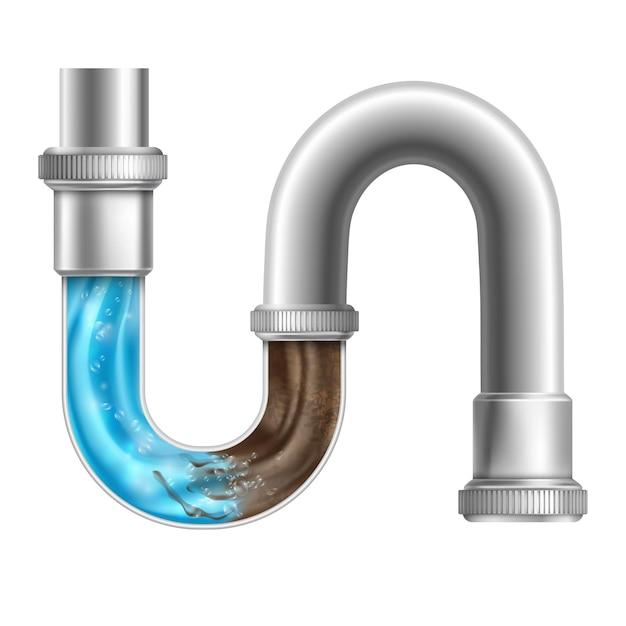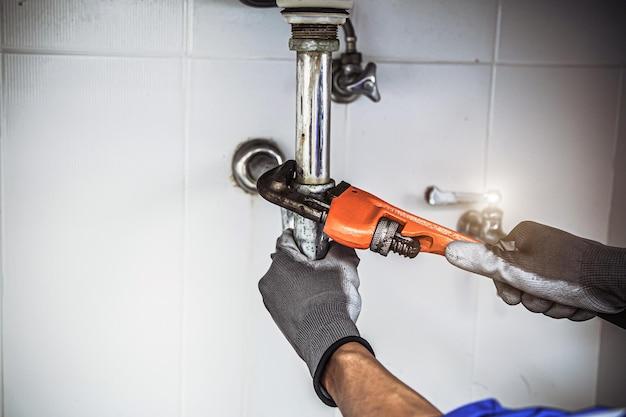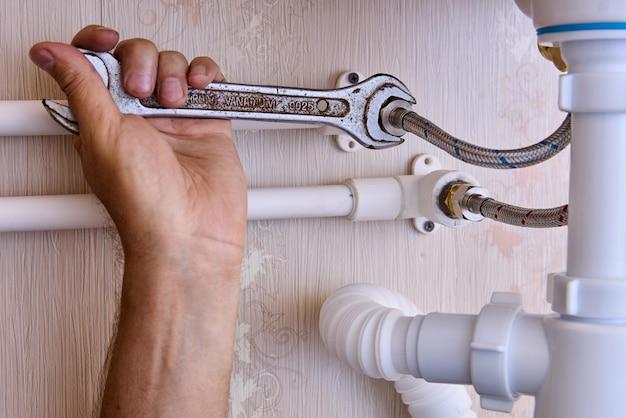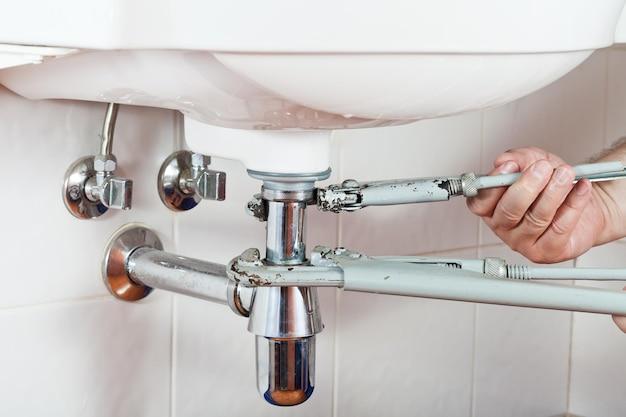Are you tired of the constant frustration of your sink pipes falling apart? Do you keep tightening them, only to find that they loosen up again in a few days? If so, you’re not alone. Many homeowners face this problem, and it can be messy, time-consuming, and costly.
There are several reasons why the pipes under your sink keep coming apart. For instance, the trap assembly may not be aligned correctly, or the fittings may not be tight enough. Moreover, the pipes could be made of a material that is not suitable for hot water or pressure, leading to leaks and disconnections.
Fortunately, there are solutions to fix this issue, regardless of whether you’re dealing with a kitchen or bathroom sink. Some techniques include using Teflon tape, tightening the fittings with channel locks or pliers, or replacing the pipes with a better material.
In this blog post, we’ll explore why these pipes under the sink keep coming loose, the signs to watch out for, and how you can fix the issue fast and efficiently. With our expert tips and tricks, you’ll be able to prevent the frustration of your sink pipes falling apart and finally enjoy a smoothly-functioning sink.
Pipes Under Sink Keep Coming Apart: A Frustrating Problem
Have you ever experienced the frustrating problem of the pipes under your sink coming apart? It’s a common issue that many homeowners face, and it can cause a lot of inconvenience and headaches. Whether you’re washing dishes, cleaning the sink, or using the garbage disposal, the last thing you want is for your pipes to come apart and cause water to leak all over your kitchen floor.
The Causes of Pipes Coming Apart
Pipes under the sink can come apart for different reasons, but the most common ones are:
- Loose Connections: When the nuts and bolts holding the pipes together are loose, the pipes can come apart easily.
- Corroded Pipes: Over time, pipes can corrode due to exposure to water and other substances, which weakens their structure and makes them prone to breaking.
- Fitting Problems: Pipes and fittings need to fit snugly together to prevent leaks. When there are fitting problems, the pipes can come apart easily.
Solutions to Keep Pipes in Place
Thankfully, there are ways to prevent pipes from coming apart under your sink and causing water damage. Here are some tips that can help you keep your pipes in place:
- Tighten Connections: Check the nuts and bolts holding your pipes together and tighten them if they are loose. Use a wrench to ensure a snug fit, but be careful not to overtighten, which can cause damage.
- Replace Corroded Pipes: If your pipes are corroded, it’s best to replace them entirely. Corroded pipes are weak and can lead to leaks or even burst, which can cause serious water damage.
- Use Pipe Sealant: Applying pipe sealant to the threads of the fittings can help create a tight seal and prevent leaks. Make sure to choose a sealant that’s compatible with your pipes and fittings.
- Install a Pipe Clamp: A pipe clamp can be installed around the pipes to hold them in place and prevent them from coming apart. This is especially useful for pipes that are located in hard-to-reach areas.
Pipes coming apart under the sink is a frustrating problem that can cause water damage and inconvenience. However, with the right solutions, you can prevent this problem and have peace of mind. Keep in mind that regular maintenance and inspection of your pipes can prevent costly repairs and replacements in the long run.
P-Trap Keeps Coming Loose
If you’ve noticed that your pipes under the sink keep coming apart, it may be due to a loose p-trap. This is where the curved pipe connects to the drain and the sink, which is responsible for preventing sewer gases from entering your home.
Causes of a Loose P-Trap
The p-trap may come loose if it wasn’t installed correctly or if it’s worn out. Constant movement from water pressure and drainage can cause fittings to loosen and the trap to slip out of place, resulting in leaks and foul odors.
Fixing the Loose P-Trap
To fix a loose p-trap, you’ll need to remove the old adhesive and clean the area before applying fresh adhesive. This will help the fittings grip better and hold the trap in place. Unbolt the p-trap from the sink and remove any debris before repositioning the trap back into place. Make sure the fittings are tight and create a strong seal.
Preventing a Loose P-Trap
Prevention is key when it comes to keeping your p-trap intact. Ensure that the fittings are tight and free of debris regularly. Don’t overtighten them, as this can cause breakage or additional wear and tear. Additionally, consider getting a plumber to inspect the p-trap annually to ensure long-term maintenance and functionality.
By fixing a loose p-trap, you’ll not only prevent leaks and foul odors, but you’ll also improve the functionality of your sink. Keep these tips in mind to keep your pipes under the sink from coming apart and ensure that your home remains free of foul odors.
My Kitchen Sink Pipe Just Fell Off!
Have you ever experienced the embarrassing moment when your kitchen sink pipe suddenly falls off? Well, it happens to the best of us! In this section, we’ll discuss some possible reasons why it can happen and what you can do about it.
Why Did My Kitchen Sink Pipe Fall Off
There are a few reasons why your kitchen sink pipe may have fallen off. Here are the most common reasons:
- Loose connections
One of the most common reasons why a kitchen sink pipe falls off is because the connections are too loose. If the pipes are not tightly secured, they can easily fall apart. This can happen when the pipes are not properly tightened during installation.
- Worn out washers
Another reason why pipes can come apart is when the washers wear out. Washers are small rubber rings that are placed between the pipes to create a tight seal. Over time, these washers can wear out and cause water to leak out of the pipes, eventually causing them to come apart.
- Poor quality pipes
Cheaper pipes may be more likely to come apart than high-quality ones. This is because they don’t have the same level of durability and strength as more expensive pipes.
What Can I Do About it
If your kitchen sink pipe has fallen off, here are some things you can do about it:
- Check the connections
The first thing to do is to check the connections between the pipes. If they are loose, simply tighten them up with a pipe wrench.
- Replace worn out washers
If the washers are worn out, you’ll need to replace them. You can find replacement washers at your local hardware store. Simply remove the old washers and replace them with the new ones.
- Upgrade to high-quality pipes
If your pipes are of poor quality, consider upgrading to higher quality ones. This will help to prevent future incidents and ensure that your pipes are strong and durable.
In conclusion, a kitchen sink pipe falling off can be an embarrassing and frustrating experience, but there are ways to address the problem. By following the tips in this section, you can make sure that your pipes stay securely connected and avoid any further mishaps.
Bathroom Sink Pipe Leaking
Have you ever experienced a leaky bathroom sink pipe? There are few things more frustrating than discovering that the pipes under your sink are leaking. Not only can it be a nuisance, but it can also cause damage to your bathroom cabinet and surrounding areas. Fortunately, there are a few things you can do to fix the problem and prevent it from happening in the future.
Identify the Source of the Leak
The first step in fixing a leaky sink pipe is to identify the source of the leak. This may involve getting underneath your sink and inspecting the pipes for any visible cracks or damage. If you can’t spot the leak right away, try running water through the sink while looking for any drips or signs of moisture.
Tighten the Connections
Once you’ve identified the source of the leak, the next step is to tighten the connections. This is often enough to fix the problem, especially if the leak is coming from a loose joint or fitting. Use a wrench to tighten any loose connections, making sure not to overtighten them as this could cause damage.
Replace the Pipe
If tightening the connections doesn’t fix the leak, you may need to replace the pipe. This is a bit more involved and may require the help of a professional, especially if you’re not a handy person. You’ll need to turn off the water, disconnect the old pipe, and replace it with a new one. Make sure to choose the right pipe size and type before buying a new one.
Prevent Leaks in the Future
Preventing leaks is always preferable to fixing them. One way to do this is to make sure you’re not putting too much pressure on the pipes beneath your sink. Avoid hanging heavy items like hairdryers or storing heavy objects under the sink. Another way is to check the pipes regularly for any signs of wear, tear, or damage.
In conclusion, a leaky bathroom sink pipe is not a problem to ignore. The above solutions will help in fixing the issue. By determining the issue’s source, tightening connections, replacing the pipe and preventing future leaks, you’ll save time, money, and unnecessary stress.
PVC Pipe Keeps Coming Apart
If you’re dealing with messy leaks in your PVC pipes, it’s not only annoying but also unsafe. The last thing you want is a flood or water damage, so you need to act fast. Here are some possible reasons why your PVC pipes keep coming apart and how to fix the problem:
1. Incorrect Gluing Technique
One of the most common reasons for PVC pipes coming apart is poor glue application. Whether you’re working on a DIY project or renovating your home, improper gluing technique may weaken the joint, causing it to break apart. When using PVC cement, ensure that the surfaces to be joined are clean and dry. Apply enough adhesive to both surfaces, insert the pipes, and twist them slightly to ensure even coverage. Hold the pipes in place for about 30 seconds to prevent them from coming apart.
2. Poor Quality PVC Pipes
Cheap, low-quality PVC pipes are more likely to come apart than high-grade ones. If you’ve been experiencing continuous leaks even after using the correct gluing technique, it’s possible that the problem is with the pipes themselves. Upgrading to higher quality PVC pipes may resolve the problem for good.
3. Incorrect Pipe Size
Mismatched pipe sizes can lead to a myriad of problems, including leaking pipes. Check and confirm that the pipes you’re joining have the same inner and outer diameters. If the pipe size isn’t uniform, get a proper adapter or coupler to ensure that the pipes fit properly.
4. Pressure Build-Up
In some cases, the PVC pipes may come apart because of high water pressure. It’s essential to install a pressure regulator to prevent water from exceeding the recommended limit for your pipes. High water pressure can damage your pipes, leading to leaks and, eventually, a total breakdown.
5. Pipe Age
PVC pipes have a lifespan, and as they age, they become brittle, making them more prone to breakage. If you’ve ruled out all other possible causes of leaking pipes, it may be time for a complete overhaul. Consider replacing all the old pipes with new ones or carrying out a major repair to restore their functionality.
In conclusion, dealing with PVC pipes that keep coming apart can be frustrating, but with a little patience and the right approach, this problem can be resolved with minimal fuss. By following the above tips, you’ll be able to identify the cause of the problem and fix it while ensuring that your pipes remain secure for years to come.
How to Tighten Pipes Under Sink
If you’ve noticed that the pipes under your sink keep coming apart, you’re probably wondering how to fix the issue. Fortunately, tightening the pipes under your sink is an easy task that you can do with just a few tools.
Gather the Necessary Tools
Before you begin, you’ll need to gather some tools. You’ll need an adjustable wrench, plumber’s tape, and possibly a screwdriver if your pipes have screws.
Turn Off the Water Supply
Before you start tightening any pipes, turn off the water supply to the sink. You can do this by locating the shut-off valve under the sink and turning it off.
Identify the Problematic Pipe
Once the water supply is turned off, identify which pipe is loose or leaking. You can do this by inspecting the pipes under the sink or running water to see where it’s coming from.
Tighten the Pipe
Using your adjustable wrench, tighten the nuts that are holding the problematic pipe in place. You want to tighten the nuts until they are snug, but be careful not to overtighten them, as this can damage the pipe or cause it to crack.
Apply Plumber’s Tape
Once you’ve tightened the nuts, wrap plumber’s tape around the threads of the pipe. This will help prevent any leaks from occurring.
Turn the Water Supply Back On
After you’ve tightened the problematic pipe and applied plumber’s tape, turn the water supply back on to the sink.
Congratulations! You’ve successfully tightened the pipes under your sink. If you still notice any leaks or loose pipes, you may need to replace the pipes altogether or call a professional plumber for assistance.
Plastic Pipe Under Sink Disconnected
If you have a plastic pipe under your sink that keeps disconnecting, don’t worry; you’re not alone. It’s a common issue that can be frustrating to deal with. In this section, we’ll look at some of the reasons why plastic pipes under sinks keep disconnecting and how to fix the problem.
Reason for Disconnection
One of the most common reasons why plastic pipes under sinks keep disconnecting is because they aren’t installed correctly. If the pipes aren’t aligned correctly, they can easily come apart, causing leaks and other issues. Another reason could be the type of fittings used in the plumbing system. If they aren’t the right size or type, they may not be able to hold the pipe in place.
Fixing the Problem
If your plastic pipe under the sink keeps disconnecting, there are a few things you can do to fix it. First, make sure the pipes are correctly aligned and seated. Take the time to check them and ensure that they are secure. If the alignment is wrong, you may need to re-install the pipes.
Another option is to replace the fittings with ones that are designed to hold the pipes in place. Use fittings that are the right size, type, and material for your plumbing system. It’s always better to get the best quality fittings that will withstand the test of time.
Prevention
The best way to avoid plastic pipes under sinks from disconnecting is to make sure they are installed correctly in the first place. Hire a professional plumber who can ensure the pipes are correctly aligned, properly installed, and the right fittings used.
Conclusion
It can be annoying to deal with disconnected plastic pipes under sinks, but it’s essential to take care of it as soon as possible. By ensuring that the pipes are correctly aligned and the right fittings used, you can quickly fix the problem. Remember, when in doubt, always contact a professional plumber to take a look at the issue.
What is the Pipe Underneath a Sink Called
If you’re experiencing problems with the pipes under your sink, it’s essential to know what you’re dealing with. The pipe that goes directly underneath your sink is called the tailpiece. It’s a straight pipe that comes down from the sink and connects to a curved pipe called the P-trap.
Tailpiece
The tailpiece is a straight pipe that’s usually made of PVC or metal. It runs from the bottom of the sink basin down to the P-trap, and it’s often attached to the sink with a threaded nut. Some tailpieces are easy to remove, while others may require special tools or skills.
P-Trap
The P-trap is a curved pipe that’s shaped like a “P” or “U” and is designed to hold water to prevent sewer gases from escaping through the sink drain. Over time, the P-trap may become clogged with debris, which can cause the sink to drain slowly or not at all.
J-Bend
The J-bend is another name for the P-trap, and it’s called a J-bend because of its distinctive “J” shape. In some cases, the J-bend may be replaced by a less conspicuous bottle trap, which is a smaller, more streamlined trap that’s perfect for small spaces.
Knowing what the different parts of your sink’s plumbing system are called will give you a better understanding of how they work and how to fix them if they break. In most cases, fixing a clogged sink is relatively easy and can be done in a matter of minutes. If you’re not comfortable working with plumbing, it’s always best to call in a professional plumber who can diagnose and fix the problem quickly and safely.
How to Tighten Pipes Under the Sink
Have you ever noticed that the pipes under your sink keep coming apart? This can be frustrating, especially when you have to keep tightening them. In this subsection, we’ll explore some tips and tricks for tightening the pipes under your sink.
Identifying the Pipe
Before you start tightening the pipes, you need to identify which one is loose. The easiest way to do this is by running water and checking for leaks. Once you’ve identified the loose pipe, turn off the water and proceed to tighten it.
Using a Wrench
Most pipes under the sink are secured with nuts and bolts that require a wrench to tighten them. A crescent wrench is the best tool for the job. Place the wrench over the nut and turn it clockwise until it’s snug. Don’t overtighten the nut, or you may crack the pipe.
Wrapping with Teflon Tape
If you’ve tightened the pipe, and it’s still leaking, you may need to add Teflon tape to create a tighter seal. This tape is easy to use, and you can find it at most hardware stores. Start by wrapping the tape around the pipe’s threads in a clockwise direction. Ensure it’s snug. Be sure not to overwrap it, or it will cause a leak.
Checking for Leaks
After you’ve tightened the pipe, turn on the water and check for leaks. If the pipe is still leaking, try tightening it a bit more or wrapping it with Teflon tape. If you have tried everything, and it’s still leaking, it’s time to call a plumber.
Tightening pipes under the sink can be a challenging task, but with the right tools and knowledge, it’s a task that you can easily handle. Remember to identify the loose pipe, use a wrench, wrap Teflon tape if necessary, and check for leaks. If all else fails, call a plumber.
Kitchen Sink Drain Pipe Leaking at Connection
One of the most common problems with kitchen sink pipes is when they start to leak at the connection point. This can be a frustrating issue that leads to water damage and other problems if not fixed promptly. Here are some tips on fixing the issue:
Check the Connection
The first step in fixing a leaking kitchen sink drain pipe is to check the connection point. Tighten any loose screws or bolts and ensure that the joint is properly sealed. If the connection point is damaged, you may need to replace the joint.
Use a Plumbing Tape
If the connection point is in good condition but still leaks, use a plumbing tape to create a better seal. Simply wrap the tape around the joint and tighten the screws or bolts to secure it in place. Plumbing tape is affordable and can be found at most hardware stores.
Replace the Pipe
If the connection point is severely damaged, and you cannot create a proper seal even with plumbing tape, you should consider replacing the pipe. Always opt for a durable and high-quality replacement pipe to ensure longevity and prevent future issues.
Hire a Professional
If you aren’t confident in your ability to fix the leaking pipe, or if the problem is more complex than a simple connection issue, do not hesitate to hire a plumbing professional. They have the experience and knowledge required to identify and fix the problem promptly.
Overall, a leaking kitchen sink drain pipe can be a frustrating issue. However, with the right tools and knowledge, you can fix the issue quickly and easily. Remember to always take proper precautions and use high-quality materials to avoid similar issues in the future.



